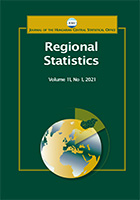Statistical assessment of spatio-temporal impact of Covid-19 lockdown on air pollution using different modelling approaches in India, 2019–2020
Statistical assessment of spatio-temporal impact of Covid-19 lockdown on air pollution using different modelling approaches in India, 2019–2020
Author(s): Debjoy Thakur, Ishapathik DasSubject(s): Social Sciences, Economy, Geography, Regional studies
Published by: Központi Statisztikai Hivatal
Keywords: lockdown intervention; seasonal influence; inverse distance weight; ordinary kriging; random forest regression kriging; difference-in-difference estimation
Summary/Abstract: One of the main contributors to air pollution is particulate matter (PMxy), which causes several Covid-19 related diseases such as respiratory problems and cardiovascular disorders. Therefore, the spatial and temporal trend analysis of particulate matter and the mass concentration of all aerosol particles ≤2.5 μm in diameter (PM2.5) have become critical to control the risk factors of co-morbidity of a patient. Lockdown plays a significant role in reducing Covid-19 cases as well as air pollution, including particulate matter concentration. This study aims to analyse the effect of the lockdown on controlling air pollution in metropolitan cities in India through various statistical modelling approaches. Most research articles in the literature assume a linear relationship between responses and covariates and take independent and identically distributed error terms in the model, which may not be appropriate for analysing such air pollution data. In this study, a pattern analysis of PM2.5 daily emissions in different main activity zones during 2019 and 2020 was performed. The seasonal effect was also taken into account when measuring the lockdown effect. The PM2.5 values at the unobserved location were predicted using three popular spatial interpolation techniques: (i) inverse distance weight (IDW), (ii) ordinary kriging (OK), and (iii) random forest regression kriging (RFK), and their root mean square error (RMSE) was compared. Subsequently, the spatio-temporal intervention of lock-down on air pollution was estimated using the difference-in-difference (DID) estima-tor. In winter, the transport zones, namely Anand Vihar and ITO airport, were the most affected regions. The northwestern part of Delhi is the most sensitive zone in terms of air pollution. Due to the lockdown, the weekly PM2.5 emission decreased by 62.15%, the mass concentration of all aerosol particles ≤10 μm in diameter (PM10) decreased by 53.14%, and the air quality index (AQI) improved by 22.40%. A proposal is made to adopt corrective measures to maintain the air pollution index, taking into account the spatial and temporal variability in the responses.
Journal: Regional Statistics
- Issue Year: 12/2022
- Issue No: 03
- Page Range: 54-84
- Page Count: 31
- Language: English

